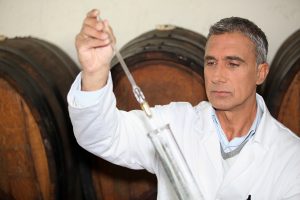
Proof is one of those terms that most of us use without entirely understanding what it means. In short, legally, a modern-day proof signifies twice the percentage of alcohol by volume in the United States. Fairly straight forward, right? So why is it really there?
Whiskey historian and author of the Rise, Fall, and Rebirth of American Whiskey, Fred Minnick, helps explain. If you go back 300 years, before instruments allowed you to determine the density of a liquid, a consumer would determine the alcohol content of a liquid by pouring it over gunpowder, lighting the powder on fire, and watching what happened. “If the alcohol was diluted with water or other non-flammable liquid, the alcohol flame went out without sparking the wet gunpowder,” says Minnick. And if it was not diluted, the gunpowder caught fire and eventually sparked. That was considered the “proof.”
So proof was essentially the point at which there was enough alcohol in a liquid for gunpowder to still spark. The terminology stuck, and that is why today we still use the term “proof” on every bottle of alcohol available for sale in the US.
Source: Nielsen December 2016
